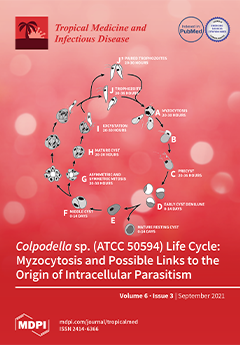Previous epidemiological studies showed that blood lead level (BLL) was associated with malaria infection and severity. Therefore, the present study aimed to qualitatively and quantitatively synthesize the evidence on the association between BLL and risk of malaria infection and severity using the systematic review and meta-analysis approach. Potentially relevant studies were identified from three databases using a combination of search terms. The quality of the included studies was assessed using the checklist for the cross-sectional studies developed by the Joanna Briggs Institute. The qualitative synthesis of the risk or odds of malaria infection in patients with BLL was performed as the outcome of each included study could not be pooled. The pooled mean BLL and prevalence of malaria infection of the included studies was estimated using a random-effect model. The heterogeneity of the outcomes among the included studies was assessed using the Cochran Q test and I
2 statistics. The subgroup analysis of the study sites and participants was performed to explore the source(s) of heterogeneity of the outcomes. Publication bias was assessed in the case of more than 10 studies used for pooling of the same outcome. Among 114 potentially relevant studies identified from the databases, 6 eligible studies were included for qualitative and quantitative syntheses. The results showed that the pooled mean BLLs were 7.33 μg/dL in children (95% confidence interval (95%CI), 4.08–10.58; I
2, 98.2%), 7.94 μg/dL in children with BLL > 45 mg/dL before chelation (95%CI, 7.87–8.01), 7.41 μg/dL in infants (95%CI, 7.34–7.48 μg/dL), 9.20 μg/dL in children with malaria (95%CI, 9.16–9.24 μg/ dL), and 36.37 μg/dL in pregnant women (95%CI, 34.43–38.31 μg/dL). The prevalence rates of malaria among participants (2381 participants, 803 malaria-positive patients) were 53% in children (95%CI, 50–57%; I
2, 99.8%), 24% in children with BLL > 45 mg/dL before chelation (95%CI, 21–27%), 12% in infants (95%CI, 8–18%), and 21% in pregnant women (95%CI, 18–26%). The subgroup analysis of countries demonstrated that the prevalence rates of malaria among participants was 17% in Benin (95%CI, 13–21%; I
2, 98.8%) and 36% in Nigeria (95%CI, 10–63%; I
2, 99.4%). BLL associated with decreased risk of malaria was demonstrated by two studies conducted in Benin and Nigeria, while BLL associated with increased risk of malaria was demonstrated by a study conducted in Nigeria. BLL was associated with the risk of severe malaria, involving severe neurological features and severe anemia. In conclusion, the present systematic review and meta-analysis determined the current status of the studies on BLL and risk of malaria in African countries. Further studies are needed to investigate the impact of BLL on patients with malaria to help the clinician determine the risk of severity, such as the development of neurological features or severe anemia, among patients exposed to lead.
Full article






